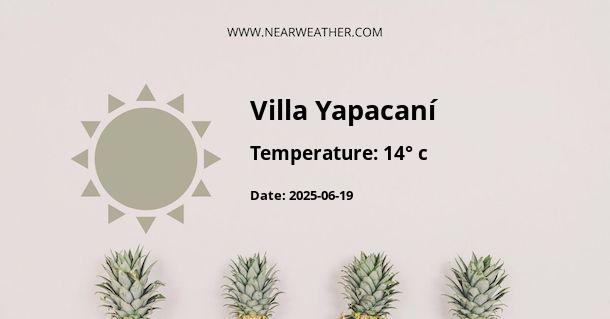Climate and Weather in Villa Yapacaní, Bolivia
Villa Yapacaní, located in the tropical lowlands of Bolivia, experiences a unique climate characterized by distinct wet and dry seasons. Understanding the weather patterns in Villa Yapacaní is crucial for residents and visitors alike to plan activities, agriculture, and anticipate potential natural events.
Annual Weather Overview
Villa Yapacaní has a tropical savanna climate, designated as Aw according to the Köppen climate classification. The climate is characterized by relatively consistent temperatures throughout the year and distinct wet and dry seasons.
| Month | High (°C) | Low (°C) | Rainfall (mm) |
|---|---|---|---|
| January | 31 | 22 | 200 |
| February | 30 | 22 | 190 |
| March | 30 | 21 | 170 |
| April | 29 | 20 | 130 |
| May | 27 | 18 | 60 |
| June | 26 | 16 | 30 |
| July | 27 | 16 | 20 |
| August | 29 | 18 | 30 |
| September | 30 | 20 | 70 |
| October | 31 | 21 | 130 |
| November | 31 | 22 | 150 |
| December | 31 | 22 | 190 |
From the months of November to March, Villa Yapacaní experiences its wet season. During this time, heavy rainfall and high humidity are characteristic, with January receiving the highest amount of precipitation. The dry season, from April to October, sees significantly less rainfall, leading to drier conditions and lower humidity.
Impacts of Weather on Agriculture and Economy
The climate of Villa Yapacaní plays a critical role in shaping the region's agricultural patterns and economy. The wet season provides essential moisture for the cultivation of various crops, including rice, corn, sugarcane, and tropical fruits. However, excessive rainfall can also lead to flooding and soil erosion, posing challenges to agricultural activities.
During the dry season, farmers rely on irrigation systems to sustain their crops, and the lower humidity creates a more conducive environment for sun-drying harvested produce. Understanding the weather patterns is crucial for effective crop planning and water management in Villa Yapacaní.
Natural Events and Climate Resilience
Villa Yapacaní, like many tropical regions, is vulnerable to natural events such as tropical storms and cyclones during the wet season. These events can bring strong winds and heavy rainfall, leading to potential damage to infrastructure and disruption of daily life.
"The impact of climate change in tropical regions like Villa Yapacaní underscores the urgency of building climate resilience and implementing sustainable adaptation strategies at the local level." - Dr. Sofia Ramirez, Environmental Scientist
Local authorities and communities in Villa Yapacaní are increasingly focused on climate resilience and disaster preparedness to mitigate the impacts of extreme weather events. This includes early warning systems, infrastructure improvements, and community-based initiatives to address the heightened risks associated with the region's climate.
Conclusion
Villa Yapacaní's tropical savanna climate brings both opportunities and challenges to the region. Understanding the distinct wet and dry seasons, along with their impacts on agriculture, economy, and resilience, is essential for sustainable development and adaptation to a changing climate. By leveraging local knowledge and scientific expertise, Villa Yapacaní can navigate the complexities of its weather patterns while building a more resilient and prosperous future.
A - Villa Yapacaní's Latitude is -17.400000 & Longitude is -63.833328.
A - Weather in Villa Yapacaní is 34° today.
A - Climate Conditions in Villa Yapacaní shows overcast clouds today.
A - Humidity in Villa Yapacaní is 28% today.
A - Wind speed in Villa Yapacaní is 10.66 km/h, flowing at 102° wind direction. today.
